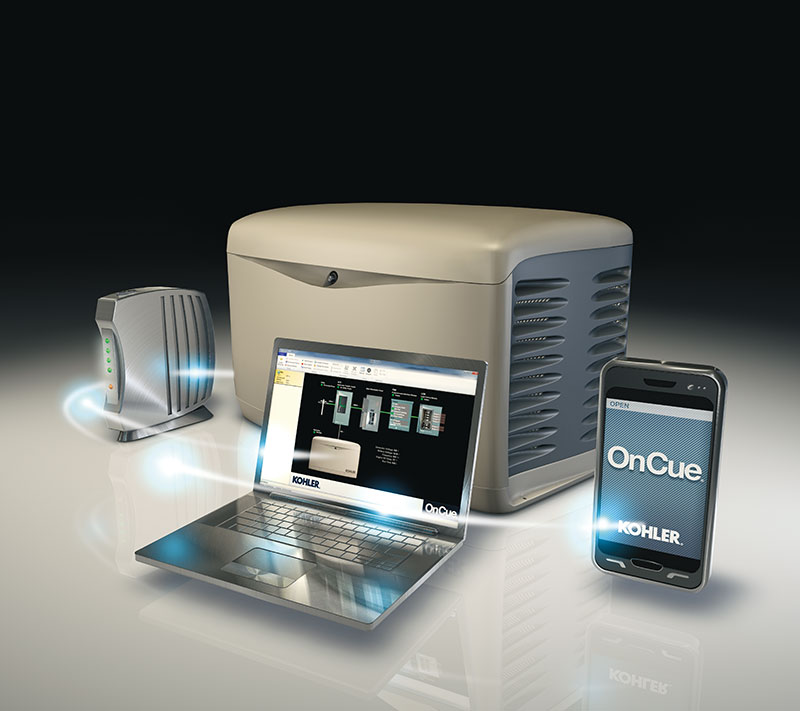With the increasing number of power outages in the U.S., many homeowners and small business owners are turning to generators to have a reliable source of power in the event of a grid outage. While there is always the possibility of the most sensitive electronic appliances being damaged by a generator, most–if not all–risk can be eliminated by selecting the right generator that will protect your electronic equipment and by operating your equipment properly.
Before we drill down into reducing the risk of damaging electronic appliances with your generator, a quick refresher course in generators may be helpful. There are two kinds of generators–portable and permanent standby. Each is designed to deliver power to a portion or all of the home or small business.
Portable generators are smaller systems that can be wheeled to any location outside of the home and are powered by gasoline. Extension cords running from the portable generator are brought inside to deliver power to specific appliances such as a furnace, refrigerator, hot water tank, laptop computer, sump pump, lighting fixtures, etc. Portable systems can be purchased at your local home improvement store and do not require installation by a licensed electrician. While portable systems are less costly, the main drawback is their limited ability to deliver voltage to your entire home. They also require manual operation, as they will not work automatically when you are away or out of town. As we will cover later, there is a newer technology available (inverter technology) that makes portable generators safer to use with the most sensitive microprocessor-based electronic appliances such as computers, tablets, smart phones and TV’s.
Permanent standby generators are larger systems placed on a pad outside the home and are powered by fixed energy sources such as a natural gas line, diesel fuel or a liquid propane tank. These systems, which are connected directly to a building’s electrical panel, immediately detect a loss of power from the local utility and will transfer power generation to the standby generator system (and away from the utility) via a “transfer switch”. These permanent standby systems are capable of assuming the full voltage workload from your utility and are installed by a licensed electrician. While these systems are more costly than portable systems, they come large enough to deliver power to your entire home or business and can operate automatically when you are not present. Virtually all permanent standby generators offered by leading manufacturers (Generac, Cummins, Briggs & Stratton, Kohler, et. al.) have built-in capability to offer “clean” and “smooth” power that will protect the most sensitive electronic appliances from being damaged.
Proper Generator Selection Can Reduce Risk of Electronic Appliance Damage.
The selection of the right generator is very important, not just for providing enough power to the appliances you want to use during a power outage but also for protecting your more sensitive electronic appliances from damage. Key decisions as you begin to shop for a generator will be the generator size required and the specific kind of generator you need. Both decisions will factor into protecting all of your appliances, ranging from the ordinary (refrigerator, lights, space heater, power tools) to the very sensitive (computers, stereo, TV sets and smart phones).
With regard to size, you will need to buy a generator big enough to handle the load you ask of it. If you overload your generator, you can not only damage the generator itself but also the the appliances connected to the generator.
Start your shopping process by determining your total power needs. Do you want to power only a few select electrical appliances or do you want to power your entire home or business? The answer to this question will lead you to either a portable generator or to a permanent standby generator. Next, make a list of the appliances that you want to use during an outage and calculate the total wattage required. You should try to be as accurate as possible when calculating the total wattage you need. In many cases, wattage is listed on the appliances themselves or can be found in the owner’s manual. As you calculate your total wattage requirement, note that many appliances have a “starting” wattage rating and a “running” wattage rating, reflecting the fact that many appliances require more power during start-up mode and less power when running. In many cases, starting wattage can be twice or three times that of the running wattage. For instance, a typical refrigerator requires around 2,200 starting watts and 700 running watts. Once you have your total wattage calculation, build in a comfortable excess cushion (1.5-2X) and you can then build a shopping list of generators by brand name and specific model number that will comfortably produce the wattage required and then some. Remember, you do not want to overload your generator and having a comfortable cushion of power generating capability is always a good idea. For an average household, it takes roughly 4-5,000 watts to provide enough electricity for basic needs such as refrigeration, cooking, water and lighting. As a rough guide, portable generators can produce between 1,000 and 5,000 watts, while permanent standby generators can produce between 5,000 watts and 50,000 watts.
If you are concerned about damaging sensitive microprocessor-based electronic products such as “high tech” refrigerators, big screen TV’s, laptops, smart phones, etc., the kind of generator you select can reduce the risk of damage to these appliances. Because microprocessors can be sensitive to the quality of power they receive, it is very important that they receive “clean” and “smooth” power and not what’s known as “dirty” power, which can be uneven and prone to voltage surges.
While many portable generators on the market today do a good job of generating electricity for basic things appliances like power tools, lights and sump pumps, they can pose a risk to some microprocessor-based electronic products as they produce “dirty” power that includes voltage spikes and drops. These spikes and drops can damage sophisticated electronics! In recent years, a new technology was developed for portable generators called inverter technology, which turns “dirty” DC power into “smoother, cleaner” AC power that is free from voltage spikes and drops, protecting the most sensitive electronics devices. Again, while many portable generators may be just fine to use with most standard appliances, a portable generator with inverter technology eliminates the risk of damage. In addition to protecting your electronics, inverter generators have other advantages over traditional portable generators: they are smaller, lighter, operate more quietly and tend to be more fuel efficient. The primary drawback of inverter generators is that they cost more than traditional portables.
Virtually all large permanent standby generators today are built with technology that produces “clean” power that is equivalent to what you receive from your utility. This clean, smooth power will protect your most sensitive electronic appliances.
Proper Generator Operation Can Also Reduce the Risk of Damage to Appliances
Because all portable generators require manual operation, special attention must be paid to operating them properly so as to reduce the risk of damage to your electronics and other appliances. Always consult your Owners Manual before using your generator. With respect to protecting appliances that are connected to portable generators, using surge-protected power strips can help protect all electrical appliances from power surges. Some other common safety precautions include: (1) making sure your generator is properly grounded (2) making sure that appliances are not plugged in to the generator when you start it (3) using outdoor-type extension cords that are rated properly for wattage (4) plugging appliances into your generator one at a time and let the generator stabilize before plugging in the next appliance (6) never plugging your portable generator into a household outlet as it can cause life-threatening back feeding for utility workers (7) never re-fuel a generator that is hot from running as it presents a fire and explosion risk and (8) always use a portable generator outdoors to eliminate carbon monoxide risk.
One of the advantages of permanent standby generators is that they turn on and off automatically without human intervention. And less human intervention means that there is less risk of damage to electronics and other appliances from operator error. When these systems detect a loss of power from the grid, they have a transfer switch that disengages your building from the utility and hands over the duty of providing electricity to the generator. Recall that these larger systems are installed by a licensed electrician, who makes sure upfront that they are the proper size relative to the load and that they protect all of your appliances, including those with sensitive microprocessors.

